INTI University FIN3214: Malaysia Monetary Policy Essay
VerifiedAdded on 2022/12/28
|8
|2493
|46
Essay
AI Summary
This essay provides a comprehensive analysis of Malaysia's monetary policy and the economic challenges it faced in 2019, as outlined in the FIN3214 coursework. It begins by highlighting the key challenges, including the US-China trade tensions, disruptions in the stock market, and the need to ensure equitable distribution of national growth. The essay then delves into the role of monetary policy in Malaysia, tracing its evolution and the instruments used by Bank Negara Malaysia to manage money supply, interest rates, and overall macroeconomic stability. It also discusses the limitations of monetary policy, such as the lack of export diversification and incentives for high-value foreign direct investments. The essay concludes by emphasizing the importance of sound monetary policies in addressing both internal and external economic factors to ensure sustainable growth and stability for the Malaysian economy, especially during a time of global economic uncertainty.
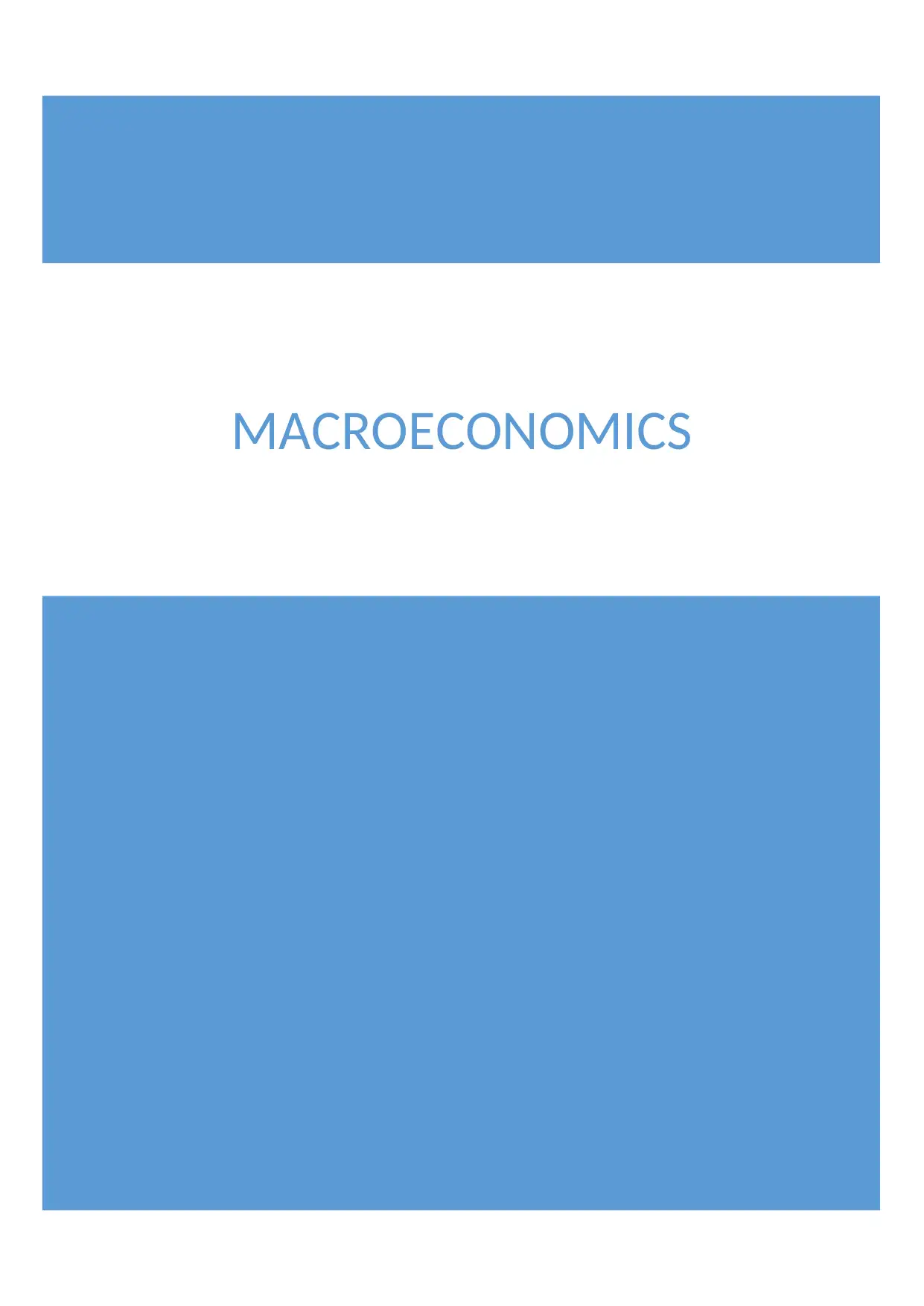
MACROECONOMICS
Paraphrase This Document
Need a fresh take? Get an instant paraphrase of this document with our AI Paraphraser
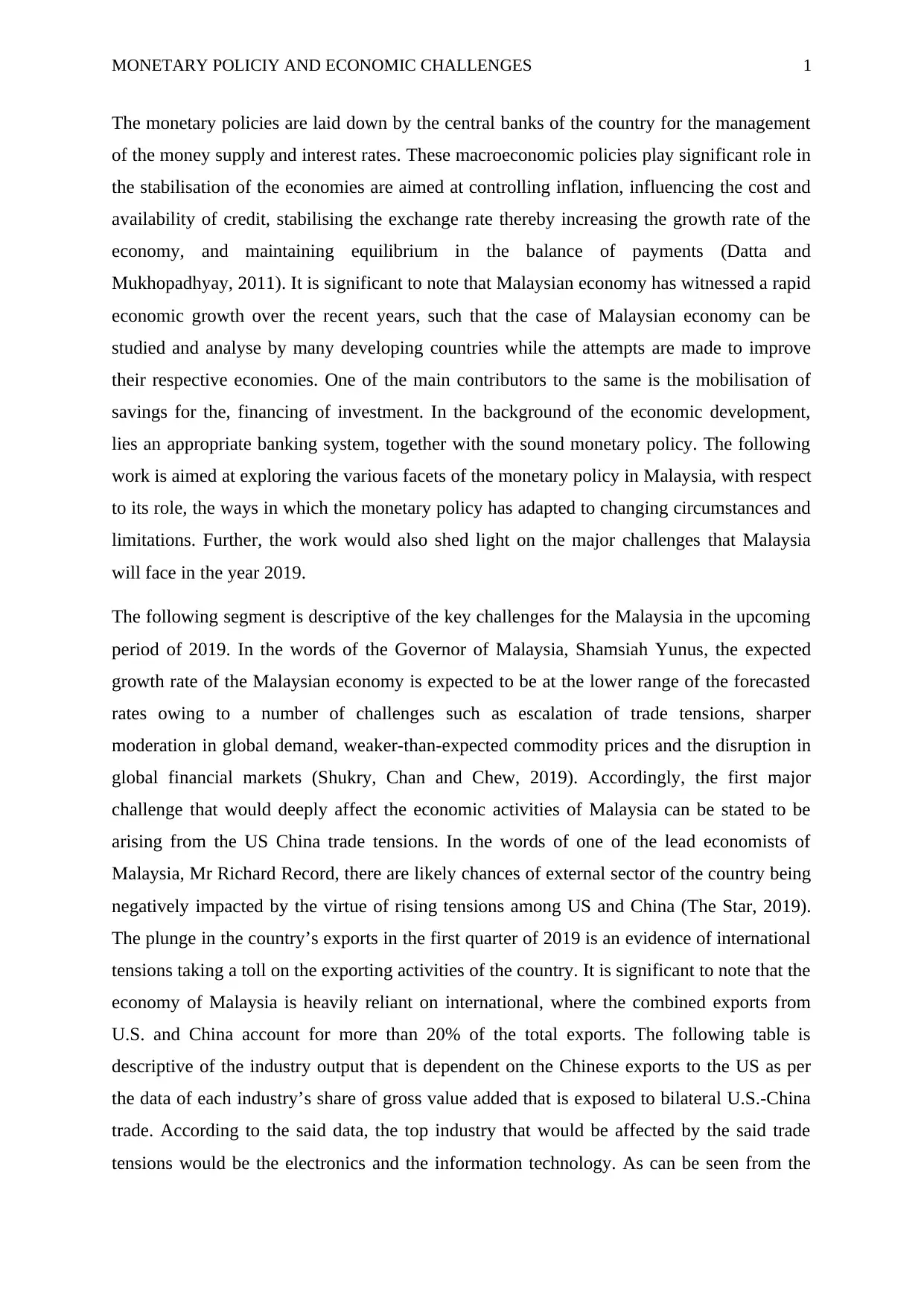
MONETARY POLICIY AND ECONOMIC CHALLENGES 1
The monetary policies are laid down by the central banks of the country for the management
of the money supply and interest rates. These macroeconomic policies play significant role in
the stabilisation of the economies are aimed at controlling inflation, influencing the cost and
availability of credit, stabilising the exchange rate thereby increasing the growth rate of the
economy, and maintaining equilibrium in the balance of payments (Datta and
Mukhopadhyay, 2011). It is significant to note that Malaysian economy has witnessed a rapid
economic growth over the recent years, such that the case of Malaysian economy can be
studied and analyse by many developing countries while the attempts are made to improve
their respective economies. One of the main contributors to the same is the mobilisation of
savings for the, financing of investment. In the background of the economic development,
lies an appropriate banking system, together with the sound monetary policy. The following
work is aimed at exploring the various facets of the monetary policy in Malaysia, with respect
to its role, the ways in which the monetary policy has adapted to changing circumstances and
limitations. Further, the work would also shed light on the major challenges that Malaysia
will face in the year 2019.
The following segment is descriptive of the key challenges for the Malaysia in the upcoming
period of 2019. In the words of the Governor of Malaysia, Shamsiah Yunus, the expected
growth rate of the Malaysian economy is expected to be at the lower range of the forecasted
rates owing to a number of challenges such as escalation of trade tensions, sharper
moderation in global demand, weaker-than-expected commodity prices and the disruption in
global financial markets (Shukry, Chan and Chew, 2019). Accordingly, the first major
challenge that would deeply affect the economic activities of Malaysia can be stated to be
arising from the US China trade tensions. In the words of one of the lead economists of
Malaysia, Mr Richard Record, there are likely chances of external sector of the country being
negatively impacted by the virtue of rising tensions among US and China (The Star, 2019).
The plunge in the country’s exports in the first quarter of 2019 is an evidence of international
tensions taking a toll on the exporting activities of the country. It is significant to note that the
economy of Malaysia is heavily reliant on international, where the combined exports from
U.S. and China account for more than 20% of the total exports. The following table is
descriptive of the industry output that is dependent on the Chinese exports to the US as per
the data of each industry’s share of gross value added that is exposed to bilateral U.S.-China
trade. According to the said data, the top industry that would be affected by the said trade
tensions would be the electronics and the information technology. As can be seen from the
The monetary policies are laid down by the central banks of the country for the management
of the money supply and interest rates. These macroeconomic policies play significant role in
the stabilisation of the economies are aimed at controlling inflation, influencing the cost and
availability of credit, stabilising the exchange rate thereby increasing the growth rate of the
economy, and maintaining equilibrium in the balance of payments (Datta and
Mukhopadhyay, 2011). It is significant to note that Malaysian economy has witnessed a rapid
economic growth over the recent years, such that the case of Malaysian economy can be
studied and analyse by many developing countries while the attempts are made to improve
their respective economies. One of the main contributors to the same is the mobilisation of
savings for the, financing of investment. In the background of the economic development,
lies an appropriate banking system, together with the sound monetary policy. The following
work is aimed at exploring the various facets of the monetary policy in Malaysia, with respect
to its role, the ways in which the monetary policy has adapted to changing circumstances and
limitations. Further, the work would also shed light on the major challenges that Malaysia
will face in the year 2019.
The following segment is descriptive of the key challenges for the Malaysia in the upcoming
period of 2019. In the words of the Governor of Malaysia, Shamsiah Yunus, the expected
growth rate of the Malaysian economy is expected to be at the lower range of the forecasted
rates owing to a number of challenges such as escalation of trade tensions, sharper
moderation in global demand, weaker-than-expected commodity prices and the disruption in
global financial markets (Shukry, Chan and Chew, 2019). Accordingly, the first major
challenge that would deeply affect the economic activities of Malaysia can be stated to be
arising from the US China trade tensions. In the words of one of the lead economists of
Malaysia, Mr Richard Record, there are likely chances of external sector of the country being
negatively impacted by the virtue of rising tensions among US and China (The Star, 2019).
The plunge in the country’s exports in the first quarter of 2019 is an evidence of international
tensions taking a toll on the exporting activities of the country. It is significant to note that the
economy of Malaysia is heavily reliant on international, where the combined exports from
U.S. and China account for more than 20% of the total exports. The following table is
descriptive of the industry output that is dependent on the Chinese exports to the US as per
the data of each industry’s share of gross value added that is exposed to bilateral U.S.-China
trade. According to the said data, the top industry that would be affected by the said trade
tensions would be the electronics and the information technology. As can be seen from the
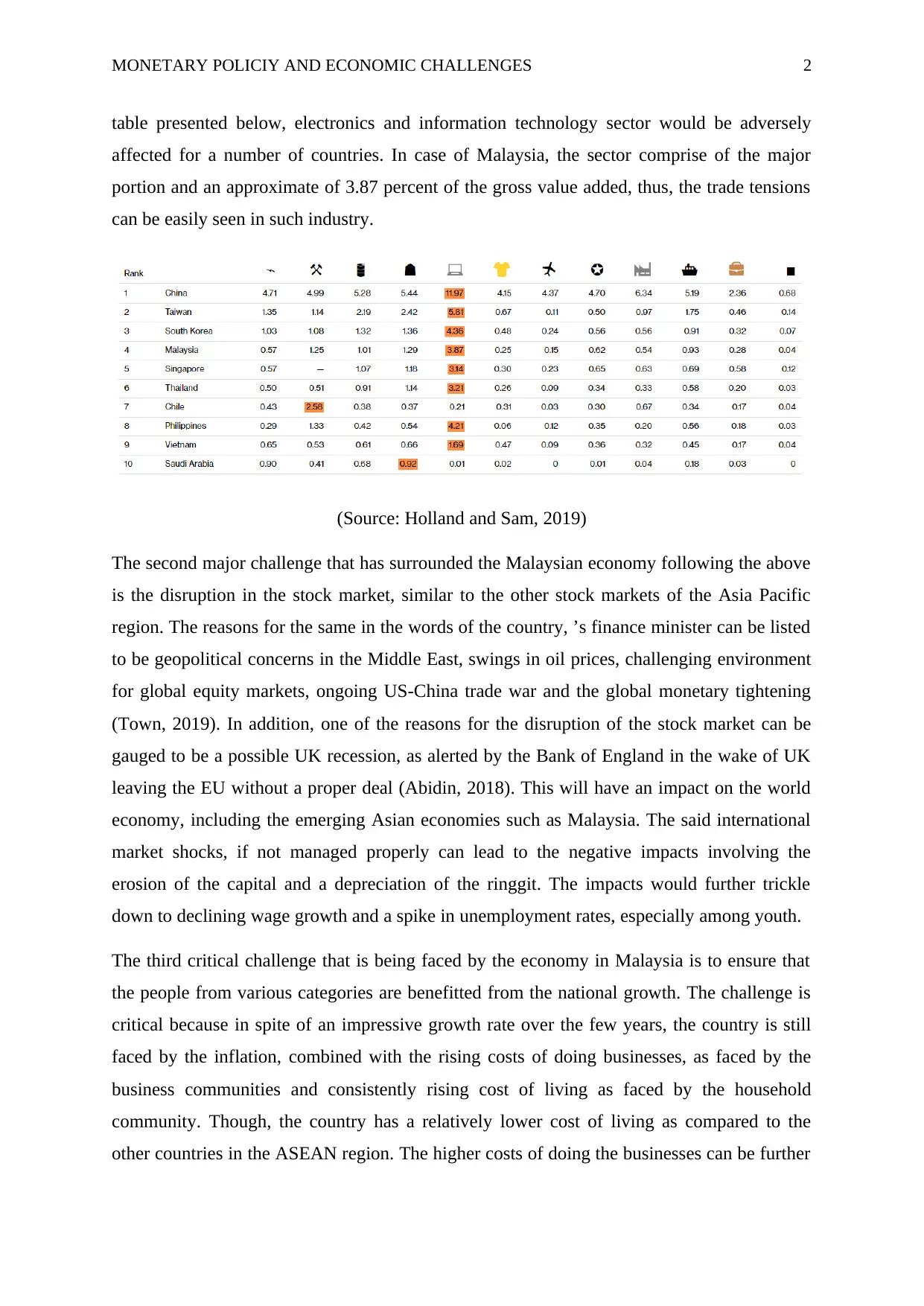
MONETARY POLICIY AND ECONOMIC CHALLENGES 2
table presented below, electronics and information technology sector would be adversely
affected for a number of countries. In case of Malaysia, the sector comprise of the major
portion and an approximate of 3.87 percent of the gross value added, thus, the trade tensions
can be easily seen in such industry.
(Source: Holland and Sam, 2019)
The second major challenge that has surrounded the Malaysian economy following the above
is the disruption in the stock market, similar to the other stock markets of the Asia Pacific
region. The reasons for the same in the words of the country, ’s finance minister can be listed
to be geopolitical concerns in the Middle East, swings in oil prices, challenging environment
for global equity markets, ongoing US-China trade war and the global monetary tightening
(Town, 2019). In addition, one of the reasons for the disruption of the stock market can be
gauged to be a possible UK recession, as alerted by the Bank of England in the wake of UK
leaving the EU without a proper deal (Abidin, 2018). This will have an impact on the world
economy, including the emerging Asian economies such as Malaysia. The said international
market shocks, if not managed properly can lead to the negative impacts involving the
erosion of the capital and a depreciation of the ringgit. The impacts would further trickle
down to declining wage growth and a spike in unemployment rates, especially among youth.
The third critical challenge that is being faced by the economy in Malaysia is to ensure that
the people from various categories are benefitted from the national growth. The challenge is
critical because in spite of an impressive growth rate over the few years, the country is still
faced by the inflation, combined with the rising costs of doing businesses, as faced by the
business communities and consistently rising cost of living as faced by the household
community. Though, the country has a relatively lower cost of living as compared to the
other countries in the ASEAN region. The higher costs of doing the businesses can be further
table presented below, electronics and information technology sector would be adversely
affected for a number of countries. In case of Malaysia, the sector comprise of the major
portion and an approximate of 3.87 percent of the gross value added, thus, the trade tensions
can be easily seen in such industry.
(Source: Holland and Sam, 2019)
The second major challenge that has surrounded the Malaysian economy following the above
is the disruption in the stock market, similar to the other stock markets of the Asia Pacific
region. The reasons for the same in the words of the country, ’s finance minister can be listed
to be geopolitical concerns in the Middle East, swings in oil prices, challenging environment
for global equity markets, ongoing US-China trade war and the global monetary tightening
(Town, 2019). In addition, one of the reasons for the disruption of the stock market can be
gauged to be a possible UK recession, as alerted by the Bank of England in the wake of UK
leaving the EU without a proper deal (Abidin, 2018). This will have an impact on the world
economy, including the emerging Asian economies such as Malaysia. The said international
market shocks, if not managed properly can lead to the negative impacts involving the
erosion of the capital and a depreciation of the ringgit. The impacts would further trickle
down to declining wage growth and a spike in unemployment rates, especially among youth.
The third critical challenge that is being faced by the economy in Malaysia is to ensure that
the people from various categories are benefitted from the national growth. The challenge is
critical because in spite of an impressive growth rate over the few years, the country is still
faced by the inflation, combined with the rising costs of doing businesses, as faced by the
business communities and consistently rising cost of living as faced by the household
community. Though, the country has a relatively lower cost of living as compared to the
other countries in the ASEAN region. The higher costs of doing the businesses can be further
⊘ This is a preview!⊘
Do you want full access?
Subscribe today to unlock all pages.

Trusted by 1+ million students worldwide
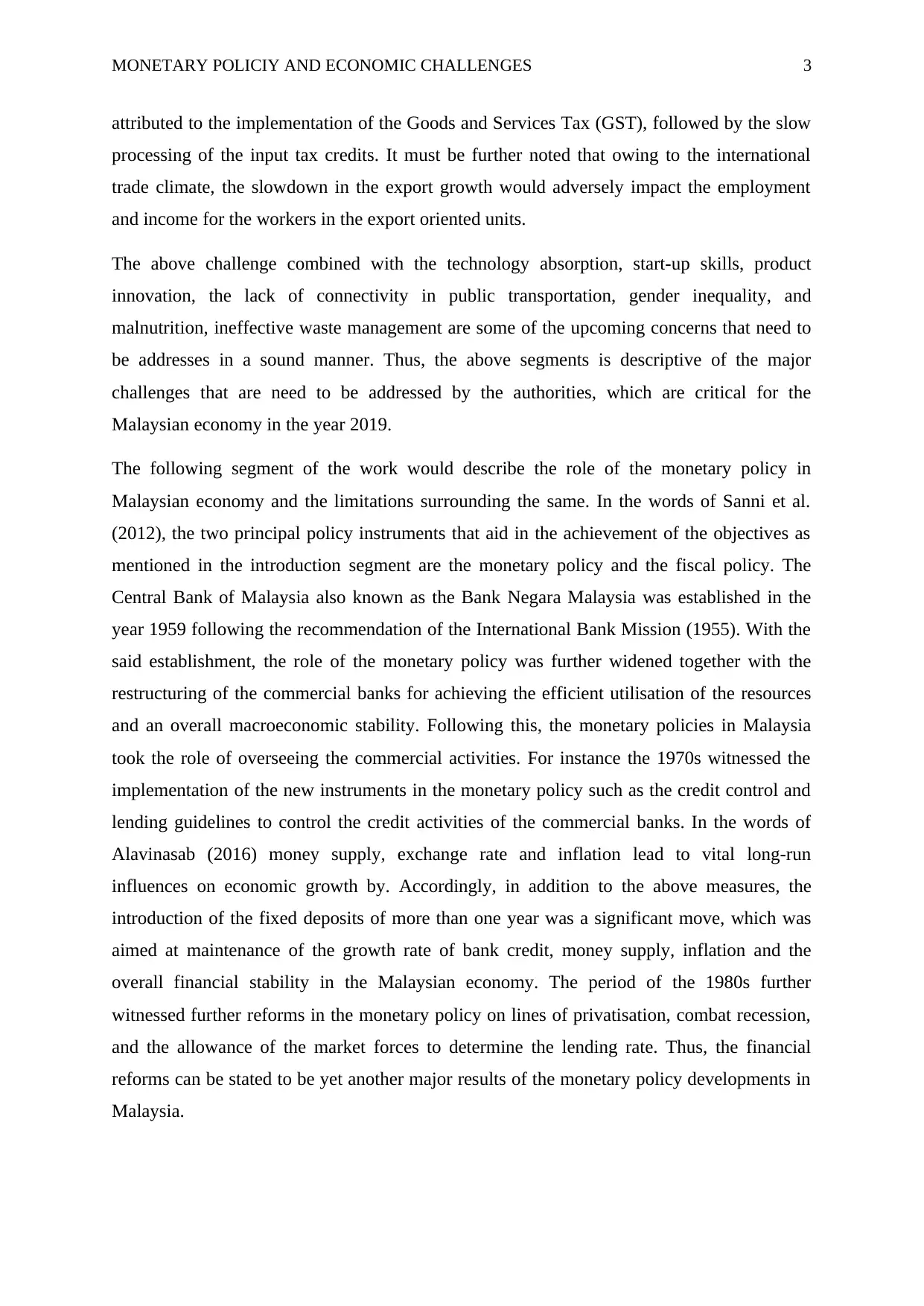
MONETARY POLICIY AND ECONOMIC CHALLENGES 3
attributed to the implementation of the Goods and Services Tax (GST), followed by the slow
processing of the input tax credits. It must be further noted that owing to the international
trade climate, the slowdown in the export growth would adversely impact the employment
and income for the workers in the export oriented units.
The above challenge combined with the technology absorption, start-up skills, product
innovation, the lack of connectivity in public transportation, gender inequality, and
malnutrition, ineffective waste management are some of the upcoming concerns that need to
be addresses in a sound manner. Thus, the above segments is descriptive of the major
challenges that are need to be addressed by the authorities, which are critical for the
Malaysian economy in the year 2019.
The following segment of the work would describe the role of the monetary policy in
Malaysian economy and the limitations surrounding the same. In the words of Sanni et al.
(2012), the two principal policy instruments that aid in the achievement of the objectives as
mentioned in the introduction segment are the monetary policy and the fiscal policy. The
Central Bank of Malaysia also known as the Bank Negara Malaysia was established in the
year 1959 following the recommendation of the International Bank Mission (1955). With the
said establishment, the role of the monetary policy was further widened together with the
restructuring of the commercial banks for achieving the efficient utilisation of the resources
and an overall macroeconomic stability. Following this, the monetary policies in Malaysia
took the role of overseeing the commercial activities. For instance the 1970s witnessed the
implementation of the new instruments in the monetary policy such as the credit control and
lending guidelines to control the credit activities of the commercial banks. In the words of
Alavinasab (2016) money supply, exchange rate and inflation lead to vital long-run
influences on economic growth by. Accordingly, in addition to the above measures, the
introduction of the fixed deposits of more than one year was a significant move, which was
aimed at maintenance of the growth rate of bank credit, money supply, inflation and the
overall financial stability in the Malaysian economy. The period of the 1980s further
witnessed further reforms in the monetary policy on lines of privatisation, combat recession,
and the allowance of the market forces to determine the lending rate. Thus, the financial
reforms can be stated to be yet another major results of the monetary policy developments in
Malaysia.
attributed to the implementation of the Goods and Services Tax (GST), followed by the slow
processing of the input tax credits. It must be further noted that owing to the international
trade climate, the slowdown in the export growth would adversely impact the employment
and income for the workers in the export oriented units.
The above challenge combined with the technology absorption, start-up skills, product
innovation, the lack of connectivity in public transportation, gender inequality, and
malnutrition, ineffective waste management are some of the upcoming concerns that need to
be addresses in a sound manner. Thus, the above segments is descriptive of the major
challenges that are need to be addressed by the authorities, which are critical for the
Malaysian economy in the year 2019.
The following segment of the work would describe the role of the monetary policy in
Malaysian economy and the limitations surrounding the same. In the words of Sanni et al.
(2012), the two principal policy instruments that aid in the achievement of the objectives as
mentioned in the introduction segment are the monetary policy and the fiscal policy. The
Central Bank of Malaysia also known as the Bank Negara Malaysia was established in the
year 1959 following the recommendation of the International Bank Mission (1955). With the
said establishment, the role of the monetary policy was further widened together with the
restructuring of the commercial banks for achieving the efficient utilisation of the resources
and an overall macroeconomic stability. Following this, the monetary policies in Malaysia
took the role of overseeing the commercial activities. For instance the 1970s witnessed the
implementation of the new instruments in the monetary policy such as the credit control and
lending guidelines to control the credit activities of the commercial banks. In the words of
Alavinasab (2016) money supply, exchange rate and inflation lead to vital long-run
influences on economic growth by. Accordingly, in addition to the above measures, the
introduction of the fixed deposits of more than one year was a significant move, which was
aimed at maintenance of the growth rate of bank credit, money supply, inflation and the
overall financial stability in the Malaysian economy. The period of the 1980s further
witnessed further reforms in the monetary policy on lines of privatisation, combat recession,
and the allowance of the market forces to determine the lending rate. Thus, the financial
reforms can be stated to be yet another major results of the monetary policy developments in
Malaysia.
Paraphrase This Document
Need a fresh take? Get an instant paraphrase of this document with our AI Paraphraser
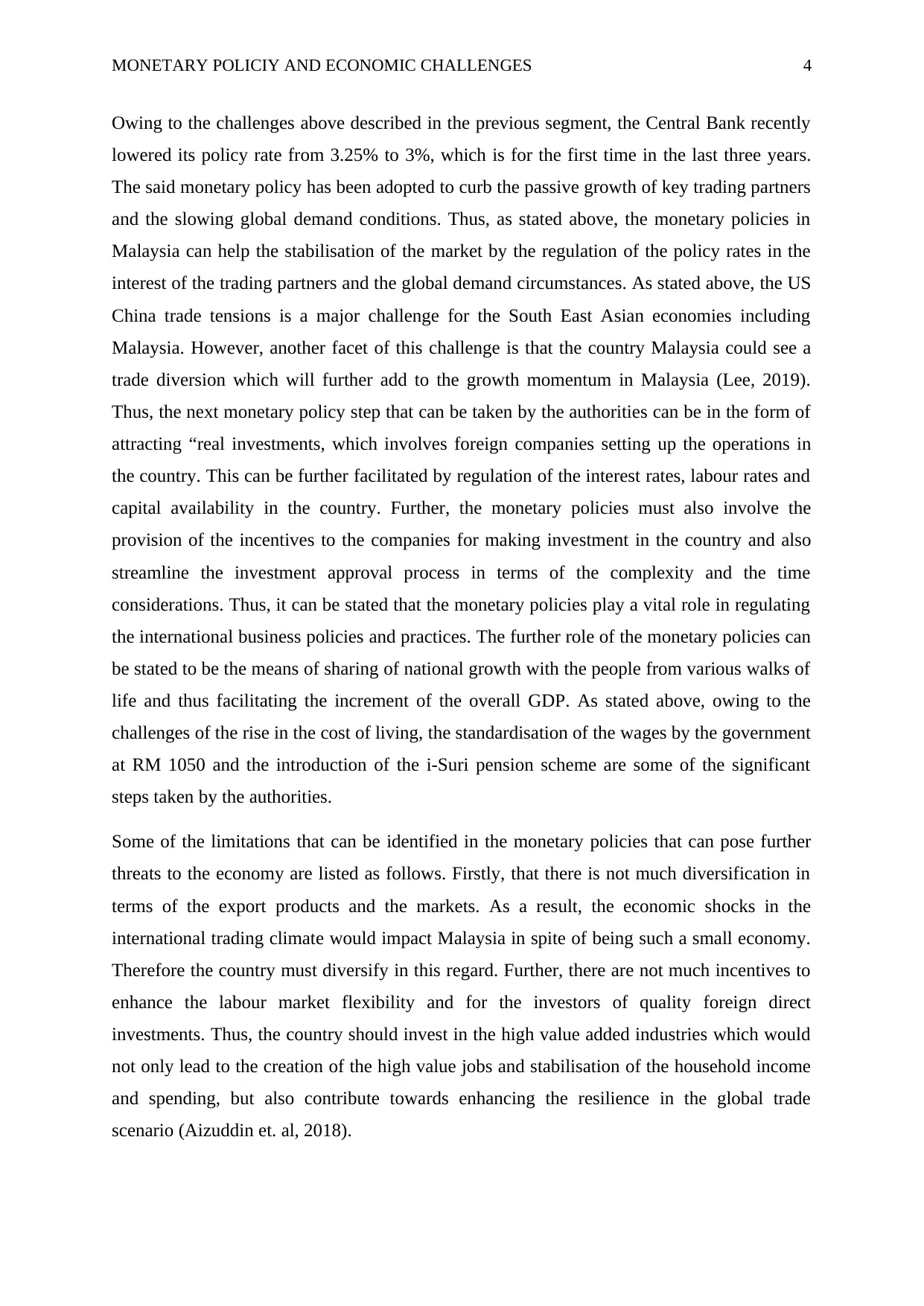
MONETARY POLICIY AND ECONOMIC CHALLENGES 4
Owing to the challenges above described in the previous segment, the Central Bank recently
lowered its policy rate from 3.25% to 3%, which is for the first time in the last three years.
The said monetary policy has been adopted to curb the passive growth of key trading partners
and the slowing global demand conditions. Thus, as stated above, the monetary policies in
Malaysia can help the stabilisation of the market by the regulation of the policy rates in the
interest of the trading partners and the global demand circumstances. As stated above, the US
China trade tensions is a major challenge for the South East Asian economies including
Malaysia. However, another facet of this challenge is that the country Malaysia could see a
trade diversion which will further add to the growth momentum in Malaysia (Lee, 2019).
Thus, the next monetary policy step that can be taken by the authorities can be in the form of
attracting “real investments, which involves foreign companies setting up the operations in
the country. This can be further facilitated by regulation of the interest rates, labour rates and
capital availability in the country. Further, the monetary policies must also involve the
provision of the incentives to the companies for making investment in the country and also
streamline the investment approval process in terms of the complexity and the time
considerations. Thus, it can be stated that the monetary policies play a vital role in regulating
the international business policies and practices. The further role of the monetary policies can
be stated to be the means of sharing of national growth with the people from various walks of
life and thus facilitating the increment of the overall GDP. As stated above, owing to the
challenges of the rise in the cost of living, the standardisation of the wages by the government
at RM 1050 and the introduction of the i-Suri pension scheme are some of the significant
steps taken by the authorities.
Some of the limitations that can be identified in the monetary policies that can pose further
threats to the economy are listed as follows. Firstly, that there is not much diversification in
terms of the export products and the markets. As a result, the economic shocks in the
international trading climate would impact Malaysia in spite of being such a small economy.
Therefore the country must diversify in this regard. Further, there are not much incentives to
enhance the labour market flexibility and for the investors of quality foreign direct
investments. Thus, the country should invest in the high value added industries which would
not only lead to the creation of the high value jobs and stabilisation of the household income
and spending, but also contribute towards enhancing the resilience in the global trade
scenario (Aizuddin et. al, 2018).
Owing to the challenges above described in the previous segment, the Central Bank recently
lowered its policy rate from 3.25% to 3%, which is for the first time in the last three years.
The said monetary policy has been adopted to curb the passive growth of key trading partners
and the slowing global demand conditions. Thus, as stated above, the monetary policies in
Malaysia can help the stabilisation of the market by the regulation of the policy rates in the
interest of the trading partners and the global demand circumstances. As stated above, the US
China trade tensions is a major challenge for the South East Asian economies including
Malaysia. However, another facet of this challenge is that the country Malaysia could see a
trade diversion which will further add to the growth momentum in Malaysia (Lee, 2019).
Thus, the next monetary policy step that can be taken by the authorities can be in the form of
attracting “real investments, which involves foreign companies setting up the operations in
the country. This can be further facilitated by regulation of the interest rates, labour rates and
capital availability in the country. Further, the monetary policies must also involve the
provision of the incentives to the companies for making investment in the country and also
streamline the investment approval process in terms of the complexity and the time
considerations. Thus, it can be stated that the monetary policies play a vital role in regulating
the international business policies and practices. The further role of the monetary policies can
be stated to be the means of sharing of national growth with the people from various walks of
life and thus facilitating the increment of the overall GDP. As stated above, owing to the
challenges of the rise in the cost of living, the standardisation of the wages by the government
at RM 1050 and the introduction of the i-Suri pension scheme are some of the significant
steps taken by the authorities.
Some of the limitations that can be identified in the monetary policies that can pose further
threats to the economy are listed as follows. Firstly, that there is not much diversification in
terms of the export products and the markets. As a result, the economic shocks in the
international trading climate would impact Malaysia in spite of being such a small economy.
Therefore the country must diversify in this regard. Further, there are not much incentives to
enhance the labour market flexibility and for the investors of quality foreign direct
investments. Thus, the country should invest in the high value added industries which would
not only lead to the creation of the high value jobs and stabilisation of the household income
and spending, but also contribute towards enhancing the resilience in the global trade
scenario (Aizuddin et. al, 2018).
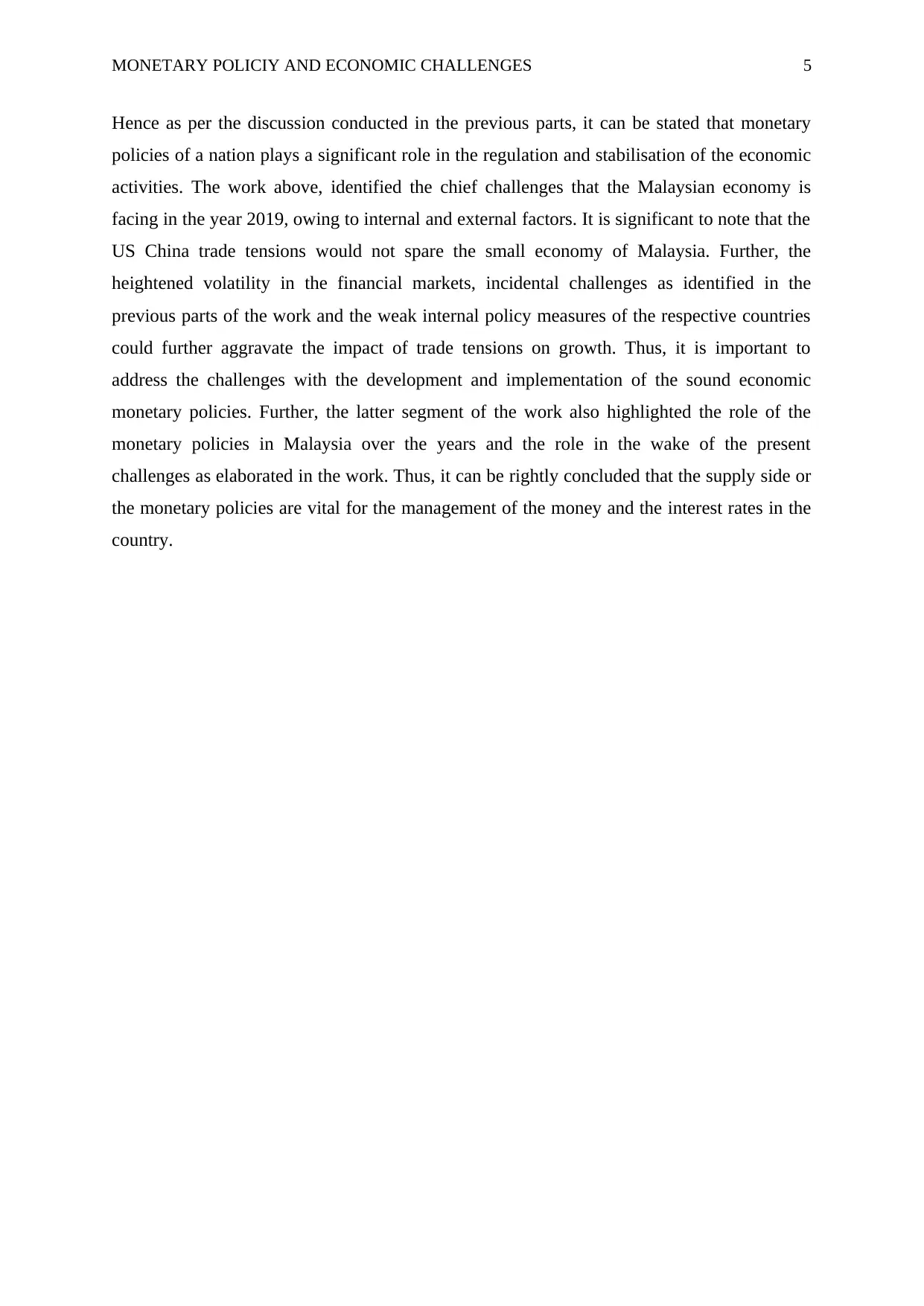
MONETARY POLICIY AND ECONOMIC CHALLENGES 5
Hence as per the discussion conducted in the previous parts, it can be stated that monetary
policies of a nation plays a significant role in the regulation and stabilisation of the economic
activities. The work above, identified the chief challenges that the Malaysian economy is
facing in the year 2019, owing to internal and external factors. It is significant to note that the
US China trade tensions would not spare the small economy of Malaysia. Further, the
heightened volatility in the financial markets, incidental challenges as identified in the
previous parts of the work and the weak internal policy measures of the respective countries
could further aggravate the impact of trade tensions on growth. Thus, it is important to
address the challenges with the development and implementation of the sound economic
monetary policies. Further, the latter segment of the work also highlighted the role of the
monetary policies in Malaysia over the years and the role in the wake of the present
challenges as elaborated in the work. Thus, it can be rightly concluded that the supply side or
the monetary policies are vital for the management of the money and the interest rates in the
country.
Hence as per the discussion conducted in the previous parts, it can be stated that monetary
policies of a nation plays a significant role in the regulation and stabilisation of the economic
activities. The work above, identified the chief challenges that the Malaysian economy is
facing in the year 2019, owing to internal and external factors. It is significant to note that the
US China trade tensions would not spare the small economy of Malaysia. Further, the
heightened volatility in the financial markets, incidental challenges as identified in the
previous parts of the work and the weak internal policy measures of the respective countries
could further aggravate the impact of trade tensions on growth. Thus, it is important to
address the challenges with the development and implementation of the sound economic
monetary policies. Further, the latter segment of the work also highlighted the role of the
monetary policies in Malaysia over the years and the role in the wake of the present
challenges as elaborated in the work. Thus, it can be rightly concluded that the supply side or
the monetary policies are vital for the management of the money and the interest rates in the
country.
⊘ This is a preview!⊘
Do you want full access?
Subscribe today to unlock all pages.

Trusted by 1+ million students worldwide
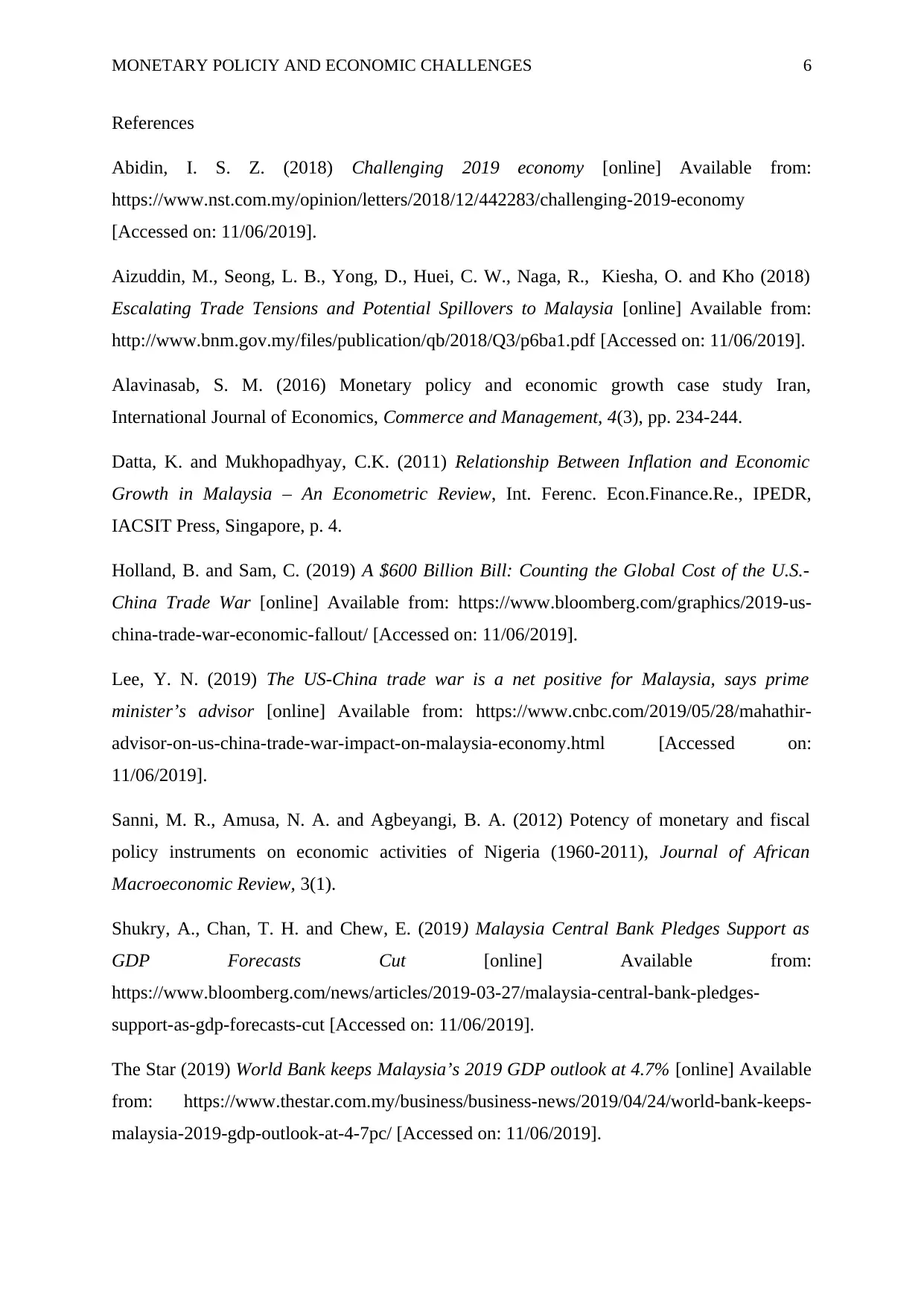
MONETARY POLICIY AND ECONOMIC CHALLENGES 6
References
Abidin, I. S. Z. (2018) Challenging 2019 economy [online] Available from:
https://www.nst.com.my/opinion/letters/2018/12/442283/challenging-2019-economy
[Accessed on: 11/06/2019].
Aizuddin, M., Seong, L. B., Yong, D., Huei, C. W., Naga, R., Kiesha, O. and Kho (2018)
Escalating Trade Tensions and Potential Spillovers to Malaysia [online] Available from:
http://www.bnm.gov.my/files/publication/qb/2018/Q3/p6ba1.pdf [Accessed on: 11/06/2019].
Alavinasab, S. M. (2016) Monetary policy and economic growth case study Iran,
International Journal of Economics, Commerce and Management, 4(3), pp. 234-244.
Datta, K. and Mukhopadhyay, C.K. (2011) Relationship Between Inflation and Economic
Growth in Malaysia – An Econometric Review, Int. Ferenc. Econ.Finance.Re., IPEDR,
IACSIT Press, Singapore, p. 4.
Holland, B. and Sam, C. (2019) A $600 Billion Bill: Counting the Global Cost of the U.S.-
China Trade War [online] Available from: https://www.bloomberg.com/graphics/2019-us-
china-trade-war-economic-fallout/ [Accessed on: 11/06/2019].
Lee, Y. N. (2019) The US-China trade war is a net positive for Malaysia, says prime
minister’s advisor [online] Available from: https://www.cnbc.com/2019/05/28/mahathir-
advisor-on-us-china-trade-war-impact-on-malaysia-economy.html [Accessed on:
11/06/2019].
Sanni, M. R., Amusa, N. A. and Agbeyangi, B. A. (2012) Potency of monetary and fiscal
policy instruments on economic activities of Nigeria (1960-2011), Journal of African
Macroeconomic Review, 3(1).
Shukry, A., Chan, T. H. and Chew, E. (2019) Malaysia Central Bank Pledges Support as
GDP Forecasts Cut [online] Available from:
https://www.bloomberg.com/news/articles/2019-03-27/malaysia-central-bank-pledges-
support-as-gdp-forecasts-cut [Accessed on: 11/06/2019].
The Star (2019) World Bank keeps Malaysia’s 2019 GDP outlook at 4.7% [online] Available
from: https://www.thestar.com.my/business/business-news/2019/04/24/world-bank-keeps-
malaysia-2019-gdp-outlook-at-4-7pc/ [Accessed on: 11/06/2019].
References
Abidin, I. S. Z. (2018) Challenging 2019 economy [online] Available from:
https://www.nst.com.my/opinion/letters/2018/12/442283/challenging-2019-economy
[Accessed on: 11/06/2019].
Aizuddin, M., Seong, L. B., Yong, D., Huei, C. W., Naga, R., Kiesha, O. and Kho (2018)
Escalating Trade Tensions and Potential Spillovers to Malaysia [online] Available from:
http://www.bnm.gov.my/files/publication/qb/2018/Q3/p6ba1.pdf [Accessed on: 11/06/2019].
Alavinasab, S. M. (2016) Monetary policy and economic growth case study Iran,
International Journal of Economics, Commerce and Management, 4(3), pp. 234-244.
Datta, K. and Mukhopadhyay, C.K. (2011) Relationship Between Inflation and Economic
Growth in Malaysia – An Econometric Review, Int. Ferenc. Econ.Finance.Re., IPEDR,
IACSIT Press, Singapore, p. 4.
Holland, B. and Sam, C. (2019) A $600 Billion Bill: Counting the Global Cost of the U.S.-
China Trade War [online] Available from: https://www.bloomberg.com/graphics/2019-us-
china-trade-war-economic-fallout/ [Accessed on: 11/06/2019].
Lee, Y. N. (2019) The US-China trade war is a net positive for Malaysia, says prime
minister’s advisor [online] Available from: https://www.cnbc.com/2019/05/28/mahathir-
advisor-on-us-china-trade-war-impact-on-malaysia-economy.html [Accessed on:
11/06/2019].
Sanni, M. R., Amusa, N. A. and Agbeyangi, B. A. (2012) Potency of monetary and fiscal
policy instruments on economic activities of Nigeria (1960-2011), Journal of African
Macroeconomic Review, 3(1).
Shukry, A., Chan, T. H. and Chew, E. (2019) Malaysia Central Bank Pledges Support as
GDP Forecasts Cut [online] Available from:
https://www.bloomberg.com/news/articles/2019-03-27/malaysia-central-bank-pledges-
support-as-gdp-forecasts-cut [Accessed on: 11/06/2019].
The Star (2019) World Bank keeps Malaysia’s 2019 GDP outlook at 4.7% [online] Available
from: https://www.thestar.com.my/business/business-news/2019/04/24/world-bank-keeps-
malaysia-2019-gdp-outlook-at-4-7pc/ [Accessed on: 11/06/2019].
Paraphrase This Document
Need a fresh take? Get an instant paraphrase of this document with our AI Paraphraser

MONETARY POLICIY AND ECONOMIC CHALLENGES 7
Town, G. (2019) 2019 will be a challenging year for Malaysia economy, finance minister
says [online] Available from: https://www.malaymail.com/news/malaysia/2019/01/05/2019-
will-be-a-challenging-year-for-malaysia-economy-finance-minister-says/1709369 [Accessed
on: 11/06/2019].
Town, G. (2019) 2019 will be a challenging year for Malaysia economy, finance minister
says [online] Available from: https://www.malaymail.com/news/malaysia/2019/01/05/2019-
will-be-a-challenging-year-for-malaysia-economy-finance-minister-says/1709369 [Accessed
on: 11/06/2019].
1 out of 8
Related Documents
Your All-in-One AI-Powered Toolkit for Academic Success.
+13062052269
info@desklib.com
Available 24*7 on WhatsApp / Email
![[object Object]](/_next/static/media/star-bottom.7253800d.svg)
Unlock your academic potential
Copyright © 2020–2025 A2Z Services. All Rights Reserved. Developed and managed by ZUCOL.





